Labrador Retrievers are the most popular dogs in the USA for a reason. They’re loyal, friendly, and affectionate.
We all know that Labradors come in different coat colors, such as black, yellow, and chocolate. But, did you know their noses vary in color, too? Chocolate Labs have brown noses while the noses of Yellow and Black Labs are black.
Although they are rare, some Yellow Labradors have flesh-colored noses. These unique pups are called Dudley Labs.
The term ”Dudley” comes from the name of the British town of Dudley, where the pink-nosed Bulldogs were bred. We now use it to describe all dogs with different nasal pigmentation.
This article will help you see why Dudley Labs are so special and what makes them different from other Labradors. It can also help you decide whether they are the right pup for you.
What is a Dudley Lab?
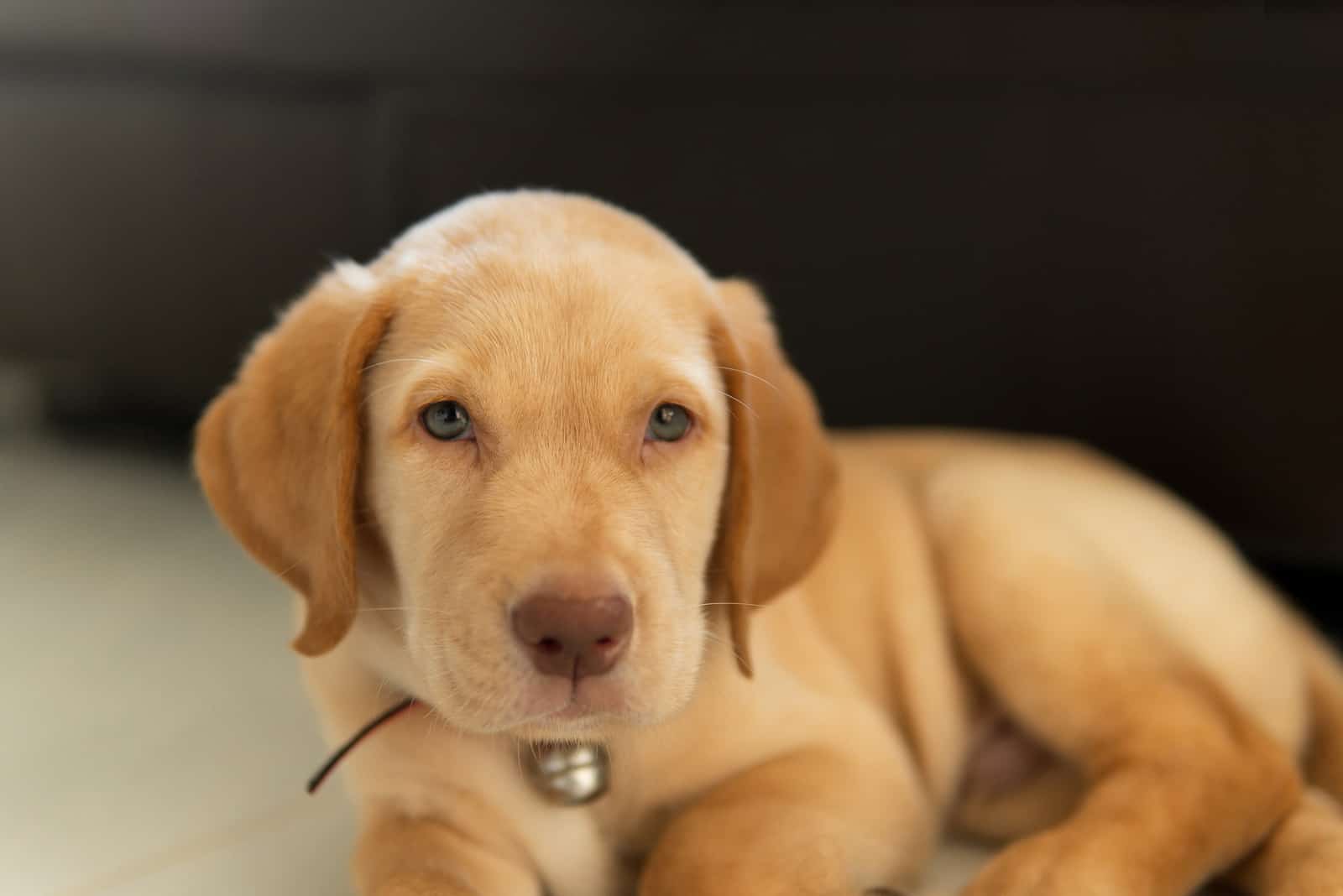
A Dudley Lab is a Labrador Retriever that lacks pigmentation on his nose, muzzle, paw pads, and eye rims. Labradors come in three colors: black, chocolate, and yellow. This genetic trait only occurs in Yellow Labs.
However, not all Yellow Labradors have pink noses, and not all pink-nosed Labs are Dudleys.
The noses of some Yellow Labs turn pink as they age, so many people confuse them for Dudley Labradors. Depigmentation in older dogs occurs when the melanin-producing enzyme, called tyrosinase, becomes less effective. Siberian Huskies and Golden Retrievers are also prone to it.
Dudleys, on the other hand, lack pigmentation from birth and throughout their lives.
They’re the same friendly, outgoing pups as other dogs of their breed. The only thing that makes them different is their appearance. They can be great family dogs and furry friends that are always ready to stand by your side.
What they can’t do, however, is compete in show rings. The American Kennel Club states in their breed standard that a pink nose in Labradors calls for disqualification.
Labrador pigmentation genetics

Some people confuse Dudleys for being mixed breeds due to their noses. However, Dudley Labs are purebred dogs born to two purebred Labrador Retrievers. Their pink noses can’t be considered a genetic abnormality; they are just a rare, natural occurrence.
To understand better where the color of their noses comes from, we’ll have to take a look into Labrador genetics.
The color of the dog’s coat, skin, and eyes is determined by the density and the type of melanin in the dog’s body cells. Melanin is a natural skin pigment made by the special skin cells called melanocytes. The enzyme, tyrosinase, controls its synthesis.
The presence of this pigment in the puppy’s nose cells depends on the genes it inherits from its parents. Every Labrador Retriever has two genetic loci that affect pigment expression. They determine whether a dog is going to be black, chocolate, or yellow.
The first is called B (brown) locus, and it is responsible for the color of the dark pigment, eumelanin. The B locus has three variations: BB, Bb, and bb. Black pigmentation is a dominant trait, so a dog with a BB or a Bb genotype will express black eumelanin.
The second genetic locus is the extension (E) trait. It determines if the eumelanin pigments will be expressed in the fur or only in the skin.
There are three genotypes for the extension, allele: EE, Ee, and ee. A dog with at least one copy of the dominant phenotype (E) will have the fur color determined by its B locus. On the other hand, a dog with the recessive trait (ee) will have a yellow coat.
The combination of alleles has to be eebb for a Dudley puppy to be born. This means that Dudleys are the result of combining both brown (B) and extension (E) recessive alleles, which explains why they are rare.
For comparison, four genotypes produce a Black Labrador: BBEE, BBEe, BbEE, and BbEe.
Chocolate Labs have either a bbEE or a bbEe genotype while Yellow Labs with skin pigmentation have a BBee or a Bbee genotype.
Dudley Lab puppies

All Labrador puppies are born with flesh-colored noses. As they grow up, their noses start getting darker while the Dudley Lab’s nose stays the same color.
They’re fully grown up by the time they reach two years of age, but many Labs stay playful all their lives.
Dudley Labrador puppies are ready to leave their mothers at twelve weeks of age to start living with their new human family.
If you’re thinking about bringing home a Dudley puppy, there are a few things you can do to prepare for taking care of your furry buddy.
The first thing you need to do is puppy-proof your home. Puppies love to bite, especially when teething as it eases their pain. So, put away all the stuff you don’t want them to chew on and buy lots of chewing toys.
You can start with socialization and training as soon as you bring them home. Early socialization will help them adjust better, making both your lives easier.
Teaching them basic obedience commands while they’re still young will ensure that you have a well-mannered pup in the future.
It’s also helpful to read about the breed’s characteristics beforehand, so you know what to expect or pay more attention to.
Once you’re all set, you can enjoy raising your new puppy. There might be some challenges, especially if you’re new to dog ownership, but these lovable pooches will help you overcome them together.
Are Dudley Labs rare?

Only a small percentage of Labradors have the bbee genotype, which makes Dudley Labs very rare. You may have seen more than a few Labs with flesh-colored noses, but they might not have been Dudleys.
As we’ve already explained, it’s common for Labrador Retrievers to lose pigmentation as they age. That’s why many people confuse other pink nose Labradors for Dudley Labs.
Cold temperatures also affect pigmentation. This phenomenon is called Snow Nose or Winter Nose. Your Lab’s nose might turn lighter in color during the cold season, but they’ll become darker again in warmer weather.
You can differentiate Dudley Labradors from other pink-nosed Labs by paying attention to their eye rims. The Dudley’s eye rims will be pink-colored as well while other Labs retain the dark pigmentation around their eyes even when their noses lose color.
Dudley Labs may be even less common due to breeding processes. Because they can’t be registered and participate in dog shows, some breeders choose not to create pups that carry this genetic trait.
However, this doesn’t mean that there’s anything wrong with Dudleys. They just don’t fit the current breed standards.
Dudley Labrador’s physical characteristics

Apart from the unusual color of their skin, Dudley Labs look like all other Yellow Labradors.
They are medium- to large-sized dogs with a strong, muscular build. Males weigh between 65 and 80 pounds while females can weigh 55 to 70 pounds. The height of male dogs is 22.5 to 24.5 inches while the females grow to be 21.5 to 23.5 inches tall.
Labradors have wide skulls with well-proportioned, medium-length muzzles. The color of a Dudley Labrador’s muzzle is pink while it’s black in other Yellow Labs. Wide noses and floppy ears are a part of their friendly appeal.
A Dudley Lab’s eyes are oval in shape and are well set apart. The eye color is usually blue, yellow, green, or hazel since the lack of pigmentation also affects the eyes.
They have short, dense, and straight coats. The undercoats are soft and weather resistant, providing them protection from water, cold temperatures, and different ground cover.
The characteristics of their coats played a significant role throughout their history. Labradors were traditional waterdogs of Newfoundland that served as duck retrievers. They also accompanied fishermen on boats and retrieved the fish that came off the trawl.
They needed to endure being in the icy waters of the Atlantic while performing these tasks.
A distinguishing feature of Labrador Retrievers is their thick ‘’otter’’ tail. These tails served as powerful rudders when swimming, helping them to perform their initial purpose of retrieving better.
See Also: Labrador Ear Cropping: You What?!
Dudley Labrador coat colors

Although Dudleys’ noses don’t vary in color, their coats do. Their fur comes in all the different color shades as the fur of Yellow Labrador Retrievers, from fox-red to yellow, champagne, and white.
Fox-red Dudley Labrador
Red Fox or Ruby Labradors have a very distinct coat color, but kennel organizations around the world register them as a variation of Yellow Labs.
Even though they can compete in show rings, there’s often some prejudice against them. Some people go as far as to consider them as a mixed-breed due to their unique color.
To understand where this rare-colored fur comes from, we have to go back to a Labrador’s pigmentation genetics.
Apart from the two genetic loci we covered above, there are also A and C sets of genes that affect the color of a dog’s coat. These genes control the pigment called pheomelanin, which is responsible for red coloring.
Champagne Dudley Labrador
The color of a Champagne Dudley’s coat is a diluted version of yellow. These beautiful pups are very rare, but their popularity has started rising in recent years.
Many breeders will charge more for a champagne-colored puppy than for other Labradors.
For a puppy to be born with this color, it needs to inherit recessive dilute genes from both its parents, which explains why there aren’t many Champagne Dudleys around.
White Dudley Lab
White Labs are another color variation of Yellow Labrador Retrievers. They’re as rare as other Labs with unique fur colors.
White Labradors can also be a result of albinism, a genetic mutation that limits the production of color. However, White Dudleys are not albinos despite the common misconception.
Albino Labs typically have additional health problems like blindness or other eye disorders while Dudleys are prone to the same health issues as other Labs.
Dudley Labrador’s temperament
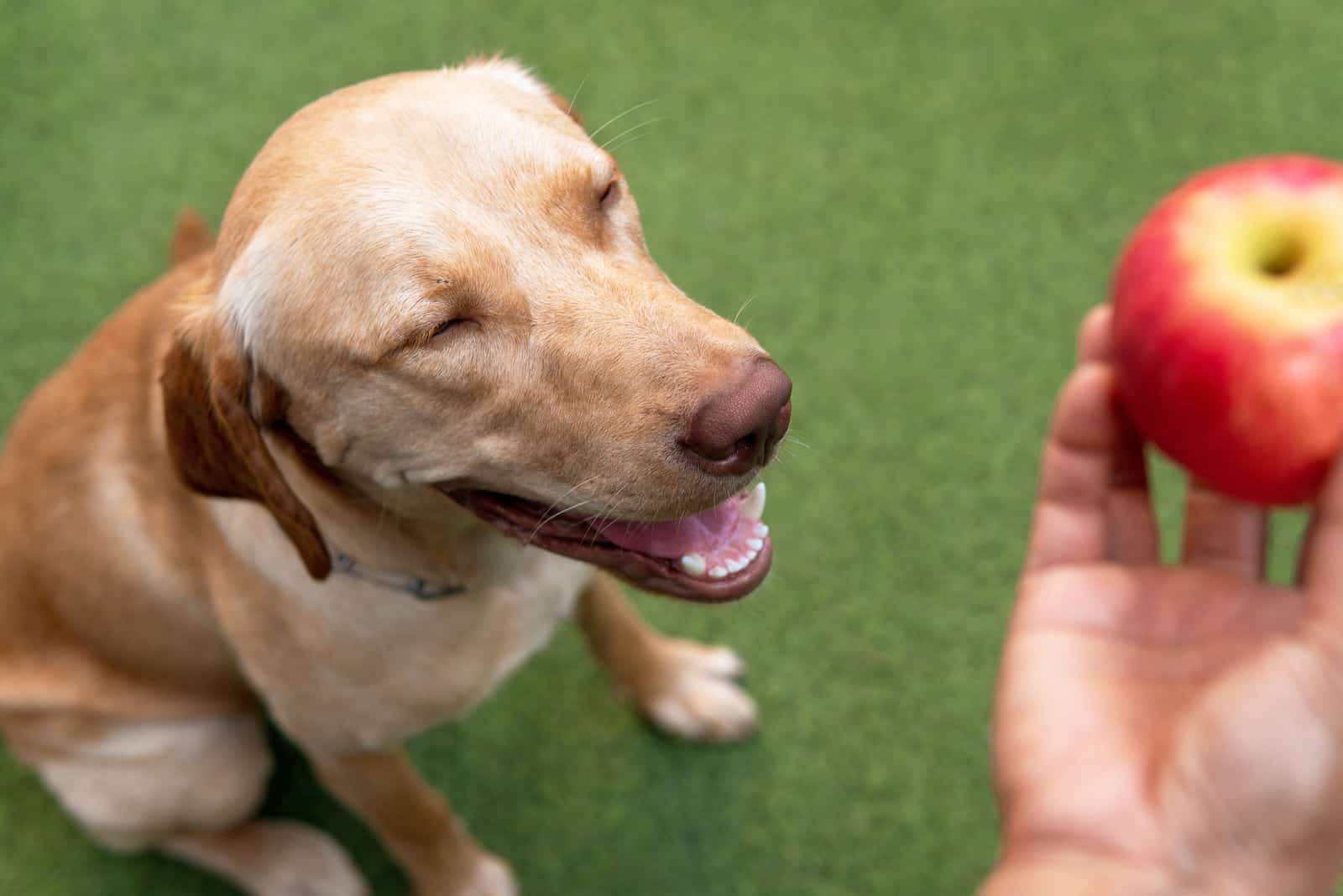
The Dudley Labs’ pink noses don’t affect their temperament. They’re the same friendly pups as all other Labradors. The AKC describes them as kind, outgoing dogs with an eager-to-please, non-aggressive nature.
The Labrador’s high intelligence and adaptability are the reason why they were employed as working dogs throughout history. Their original purpose was to retrieve waterfowl and be fishermen’s companions.
When they were brought to England in the 1800s, they were used as gun dogs. Today, field-bred Labs excel in Retriever Field Trials and Retriever Hunting Tests.
These sweet-natured pups are also great therapy dogs that bring happiness to people in nursing homes and hospitals. They also work as search-and-rescue dogs, police dogs, and detection dogs.
However, Labs are not the best watchdogs due to their friendly nature. They might even greet intruders and show them around the house.
The majority of Labs today are beloved family pets. Nevertheless, you can utilize their retrieving instinct for playing catch in the park. Being the active pups they are, they never get tired of it. Labs usually remain playful, even after they grow up.

Photo from @labrador.brian
Labradors enjoy having something to do, so they’re always in the mood for exercise. They require at least an hour of activity every day. That’s what makes them excellent companions for people with an active lifestyle. You can take them jogging, swimming, or on a playdate in the dog park to burn off their energy.
Dudley Labrador Retrievers easily bond with all the members of the family. They can be great with children and other pets, especially when they’re socialized early.
However, they can turn to destructive behavior as an outlet if they don’t get enough exercise or attention, like excessive chewing, barking, or digging. That’s why proper training and socialization are important.
Your dog training job will be easy as they are highly trainable pups. Provide enough motivation and they’ll quickly master anything you want to teach them.
What makes Dudley Labs different from other Labradors?
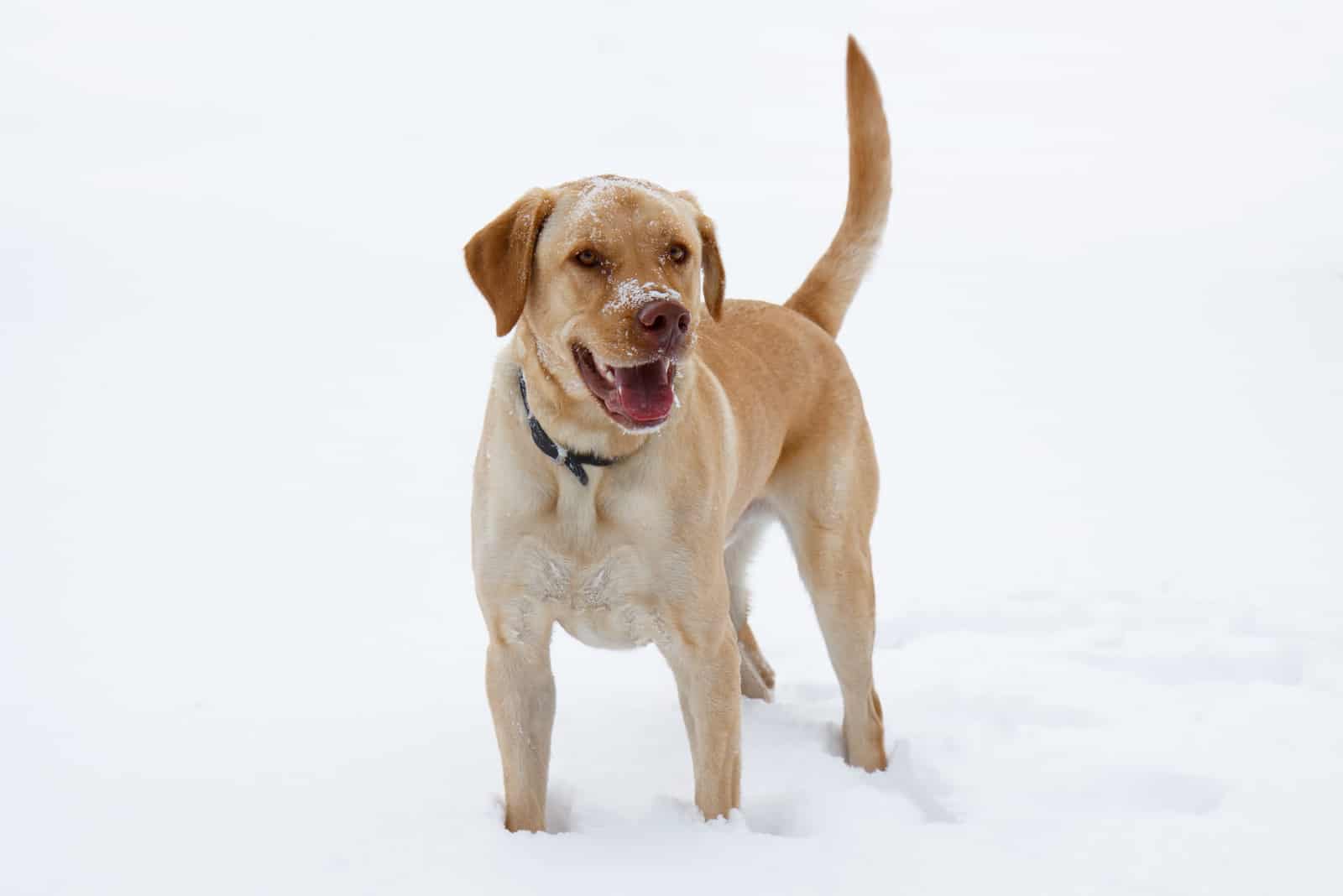
The main thing that makes Dudley Labs different from other Labradors is their genetics. Only one gene combination results in a Dudley Labrador. On the other hand, Black Labs can have four different genotypes while Yellow Labs with skin pigmentation, along with Chocolate Labs, can have two genotypes.
That’s why Dudley Labrador Retrievers are much rarer than other Labradors.
Since genetics determine a dog’s appearance, Dudley Labs differ in this aspect from other Labradors. The main physical difference between Dudleys and the rest of the Labs is the color of their skin.
The noses of Dudley Labs are pink while Chocolate Labs have brown noses. Black Labradors and pigmented Yellow Labs have black noses.
Other exposed parts of a Dudley Lab’s skin, like the muzzle, eye rims, and paw pads, are pink as well. This is what differentiates them from other pink-nosed Labs.
Dudley Labradors usually have lighter eye color, especially compared to Brown and Black Labs. Dudleys can have blue, hazel, yellow, or green eyes.
They can have the same coat colors as other Yellow Labradors, ranging from beige to darker shades of yellow.
When it comes to their size and other physical characteristics, they are similar to other variations of the Labrador breed. The Labrador color doesn’t affect temperament either, so they’re the same lovable, playful pups as all other Labs.
They also have the same average lifespan and often deal with the same health issues. However, they are more prone to sunburns due to their light-colored skin.
A Dudley Lab’s lifespan
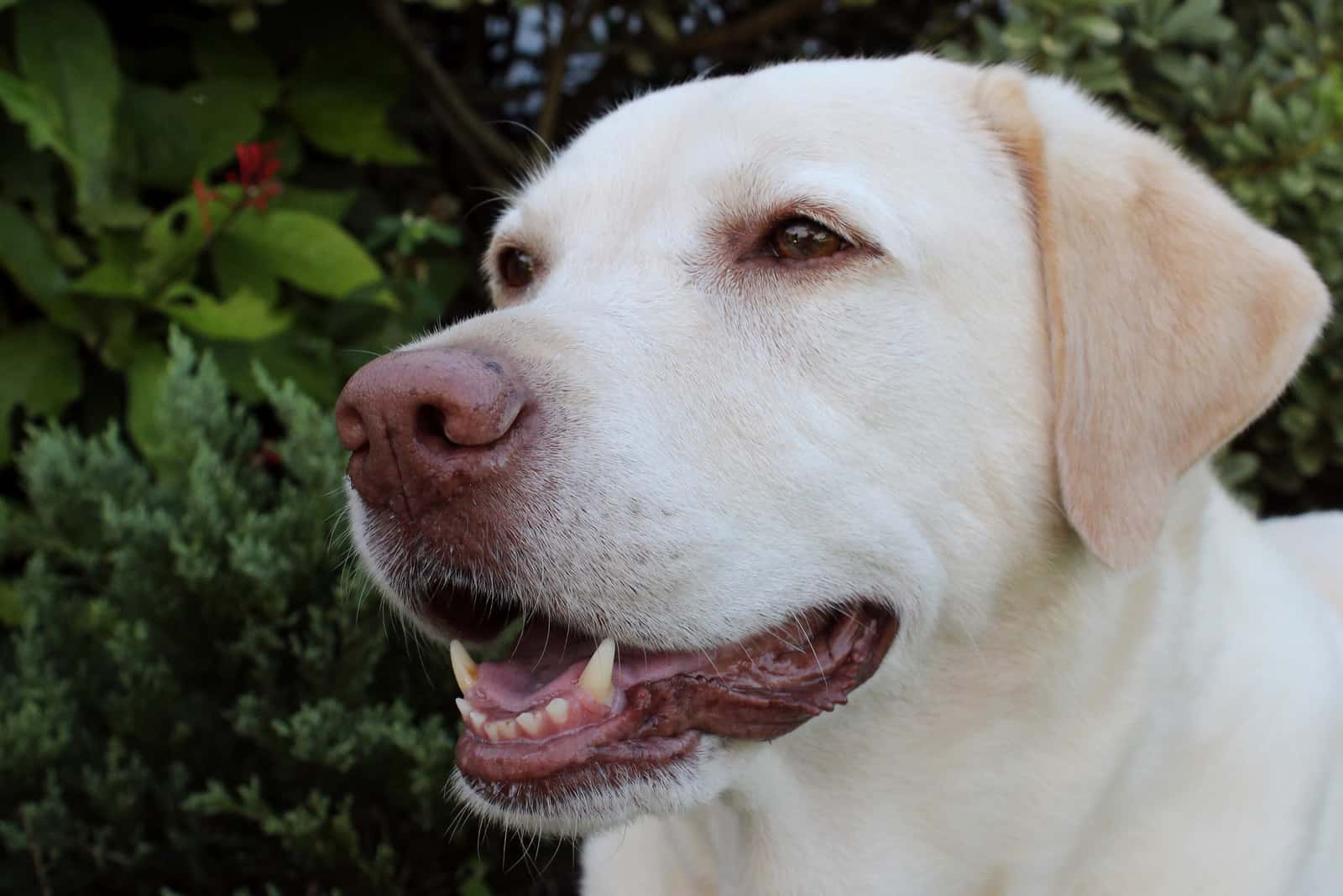
The lifespan of Dudley Labrador Retrievers is between 10 and 14 years. A study conducted in the UK showed that the average life expectancy of Labrador Retrievers is 12 years.
The study also showed that the most common causes of death for this dog breed are cancer and musculoskeletal disorders. The lifespan of Chocolate Labradors is one year shorter than the lifespans of Yellow and Black Labradors.
Although it seems too short for you, it’s an average lifespan for dogs their size. Bigger dogs tend to live shorter than smaller ones.
This doesn’t mean that your beloved Lab won’t live longer than the average. The oldest recorded Labrador was 19 years old.
You can make your pup’s life better by providing a good diet, eliminating stress, and taking care of their health. It may not drastically elongate their lifespan, but it can help them live at least a bit longer.
Health issues of Dudley Labradors
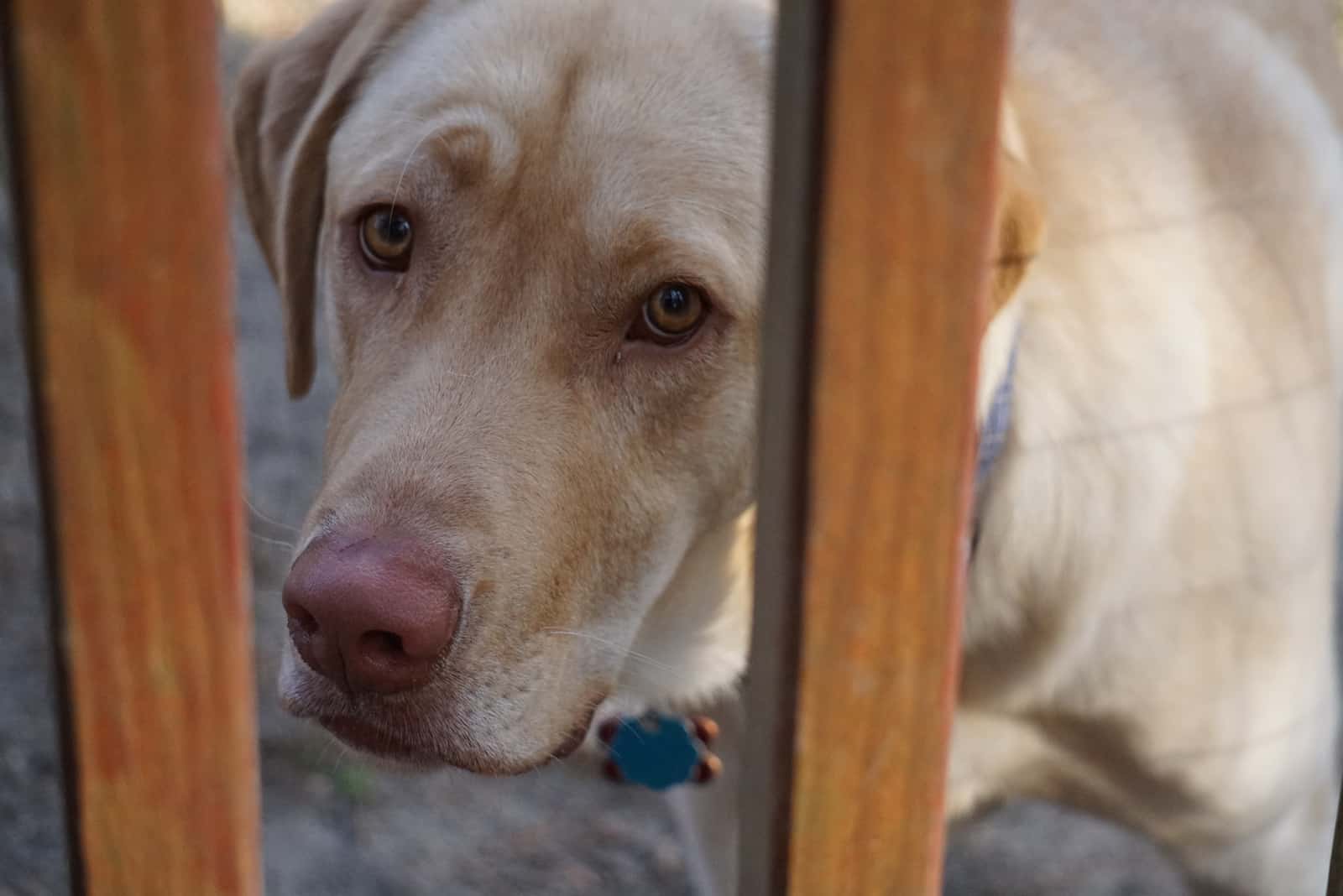
The Dudley nose doesn’t affect the dog’s overall health. Dudley Labs are prone to the same health issues as other Labrador Retrievers.
However, the lack of pigmentation does make them more prone to sunburns. This could be a serious problem for dogs living in a warmer climate as continuous sun exposure puts them at a higher risk of developing skin cancer later in life.
Remember to keep your Dudley Lab puppy out of the harsh sun, and apply dog sunscreen in the summer to protect their sensitive noses.
The most common disorders affecting Labrador Retrievers are obesity, and ear and joint conditions. The most common causes of death for this breed are musculoskeletal disorders and cancer.
Labs are motivated by food, so they have a higher prevalence of obesity than other dog breeds. Extra weight increases the dog’s chances of heart and liver disease, skeletal problems, arthritis, and metabolic and respiratory diseases.
It may be hard to resist their adorable faces when they’re begging you for more treats, but you need to stay firm and let them know when it’s enough. They won’t be happy at first, but it will save them from future problems.
Take a look at our Labrador feeding chart for more useful information on this dog’s nutrition.
Other health issues that are common in Labradors are:
1. Hip dysplasia
2. Progressive Retinal Atrophy
3. Epilepsy
4. Osteochondrosis Dissecans (OCD)
5. Bloat
Hip dysplasia is a skeletal disorder that affects the hip joint. Many dog breeds, especially larger ones like Labs, are affected by it. It’s a condition where the ball and socket of the hip joint don’t fit properly, and it can progress to arthritis.
Progressive Retinal Atrophy is a disease characterized by the slow deterioration of the photoreceptor cells, eventually leading to blindness. It’s not a painful condition, so many dog owners fail to notice it in its early stages. Some of the signs that a dog is suffering from this disease are night blindness, dilated pupils, and clumsiness in unfamiliar surroundings.
Another disease that Dudley Labs are prone to is epilepsy. If you notice that your dog is experiencing seizures, you need to contact a vet to determine whether epilepsy is causing them.
Osteochondrosis Dissecans occurs when the cartilage separates from the bone. It affects the shoulder, elbow, hip, or knee joints. Male dogs are more prone to it than females, and it typically occurs between six and nine months of age.
Bloat or Gastric Dilatation and Volvulus is a disorder where the stomach fills with gas, causing it to bloat. In some cases, it doesn’t go beyond bloating, but in others, it can be life-threatening.
How to train a Dudley Labrador

A Dudley Labs’ high intelligence, friendly nature, and obedient character make them very trainable dogs. Nevertheless, they are highly active pups, so they need a lot of exercise and proper training to keep them in check.
Dog training starts with learning to understand your dog’s psychology and creating a strong bond with them.
Dogs communicate through body language, so it’s important to recognize what different body positions mean. Tail position, for example, is a good indicator of the dog’s feelings. We all know that a wagging tail is usually a sign of a happy puppy, and a tucked tail indicates fear. Understanding the nuances of your dog’s behavior will make the training easier.
The way you raise and train your pup has a significant impact on their personality. Dogs raised in a calm environment using positive reinforcement training tend to be more affectionate and well-mannered when they grow up.
There’s another reason why Labs are easy to train: they love to eat, so they’ll do anything for a treat. The downside of this is that they’re prone to weight issues, so don’t go overboard with the treats.
Labradors used as assistance dogs are actually more prone to obesity than other pups of their breed. This is because traditional training methods usually involve food as a reward, so the most gluttonous dogs perform commands the best.
After bringing home a Dudley Labrador puppy, start with socialization as early as possible. Introducing them to different people, places, and animals while they’re young will reinforce their natural friendliness. It will also prevent future behavior problems from developing.
Lack of exercise is a common cause of behavioral issues like destructive barking, chewing, or digging. Before you try to correct your dog’s behavior, you should first rule out the possibility that he’s bored.
When it comes to basic obedience training, you can start as soon as you bring your Dudley Lab puppy home. Labs love to learn, so teaching them basic commands won’t be a hard job.
However, if you don’t have enough time for it, you can enroll them in an obedience class with a professional trainer.
Are Dudley Labs more expensive than other Labradors?

The price of Dudley Labrador puppies can vary greatly depending on the breeder you’re getting the puppy from.
Some breeders will charge you more for a Dudley Lab because they see the pink nose as a unique quality. Others might charge less for a Dudley Lab than for other Labradors since they don’t fit the breed standard.
The price of regular Labrador Retrievers ranges from $1,000 to $3,000. There’s also the price of owning a dog, which includes food, treats, veterinary care, obedience school, toys, and other dog things.
The expenses will be the highest at the beginning of your dog-owning journey, but they’ll subside later on.
Should you get yourself a Dudley Lab puppy?
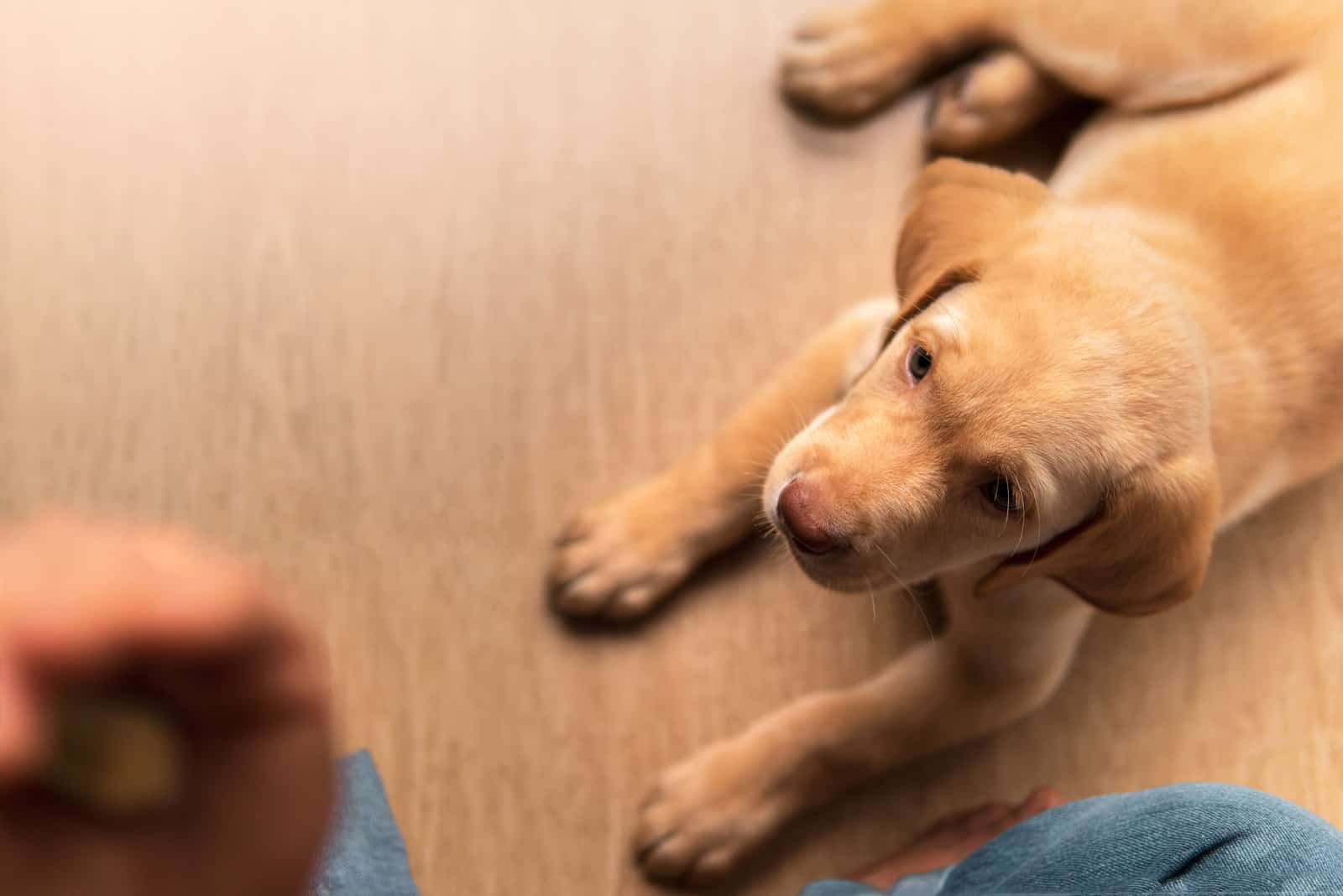
After reading about the Dudley Lab and seeing how adorable they look, you might feel like they’re the best dog for you. This summary of a Dudley Lab’s characteristics will help you make the decision.
Dudley Labradors are rare, so if you’re purposefully looking for them, they might be hard to find. You can ask a breeder to create one for you, but it will cost more than a regular Labrador Retriever puppy.
You can also check breed-specific rescues and shelters in your area to see if they have Dudley Labs for adoption. Although the chances of finding one are not very high, there might be a Dudley waiting to meet their new best friend and receive all the love they deserve.
Labs are large dogs that require a lot of exercise. If you lead an active lifestyle, they’ll happily accompany you when you go for a swim, a jog, or a hike. They’re also great camping buddies since they enjoy being outside.
They are, however, prone to separation anxiety, so they don’t like being alone for too long. If you spend a lot of time away from home, maybe you should consider getting a more independent dog.
Dudley Labradors are great family dogs as they easily bond with all the humans in their life. They enjoy being around kids due to their playful nature, and they get along with other pets.
Nevertheless, young children shouldn’t be left unsupervised with any adult dog since they can hurt each other unintentionally.
Labradors are always eager to please their owners, so training them doesn’t require much effort. With enough treats and praise, they quickly learn any command you teach them.
Be careful with the number of treats, though, as these furry gluttons never refuse food.
Whatever your decision is at the end, one thing’s for sure; Dudley Labs are always there for their humans no matter what.
Read Next:
• 11 Labrador Breeders In Texas That You Can Trust
• 9 Labrador Breeders In New York That You Can Trust
• 9 Labrador Breeders In Ohio For Lovers Of This Dog Breed


